I hope everyone has been enjoying Science Week so far. Here in Galway we have the wonderful Science and Technology Festival that runs for two full weeks with lots of activities around the city and county. Read more
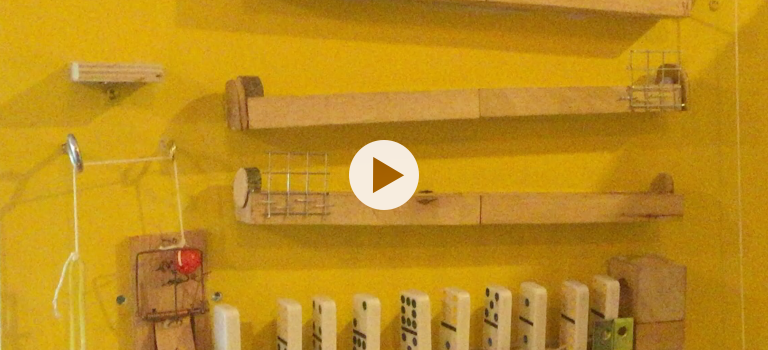
Science, Curiosity and Life

I hope everyone has been enjoying Science Week so far. Here in Galway we have the wonderful Science and Technology Festival that runs for two full weeks with lots of activities around the city and county. Read more
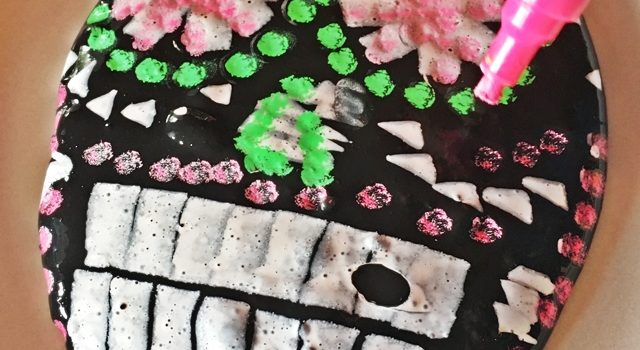
We have been experimenting with blackboard slime recently. We first spotted it here. I thought this slime would be great as a Halloween activity, covering both science and craft in one go and how right I was. Check out these cool ideas we came up with, my favourite is definitely the ‘day-of-the-dead’ decorating. Read more
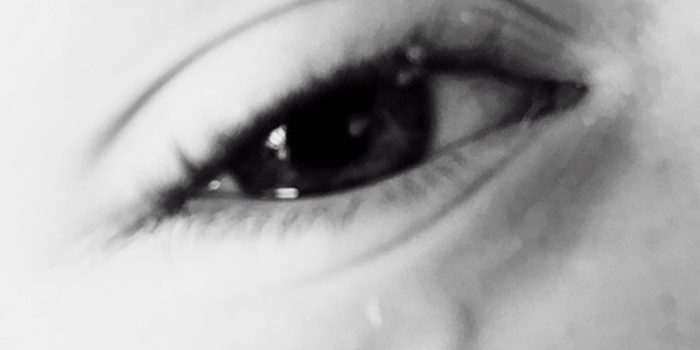
This question comes in from the very lovely, and very curious, Kayla, aged six, who can sometimes be found over at My little babóg blog. Kayla would like to know…
Where do tears come from?
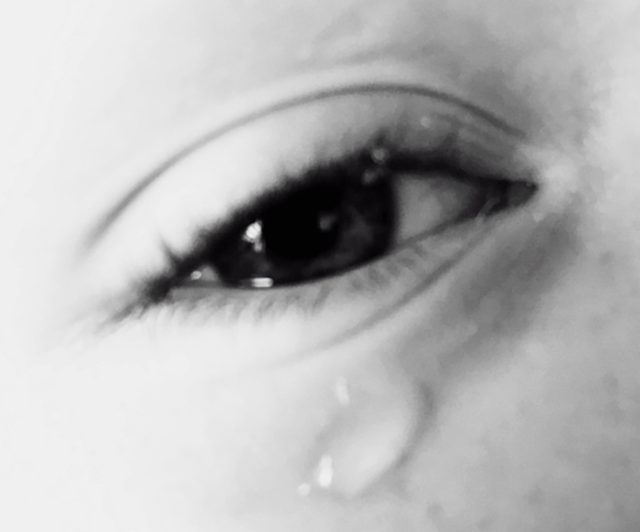
Where do tears come from?
Tears are made by little glands above our eyes, called tear glands, or lacrimal glands. There is one gland above each eye; each produce tears that travel to the eye through tiny pipes, called ducts. There are a number of these tear (lacrimal) ducts behind our upper eye lids.
Our tear ducts are constantly producing tears, to keep our eyes clean and moist, but we don’t usually even notice. When we blink we wipe the tear fluid over our eyes, keeping them moist. This fluid is then drained off from the eyes through more ducts. It is only when we start producing a lot more tears that we start to notice them. The ducts that drain the fluid away cannot cope with all the extra tears and they start to run down our cheeks.
What are tears made of?
Tears are basically made of slightly salty water. They also contain enzymes that kill bacteria and vitamins and minerals. Some tears contain proteins, called hormones, that can change how we feel.
Why do we cry?
Scientists are still working this one out. We do know that we cry different kinds of tears in response to different things. Science defines crying as the process of producing tears in response to an emotion – be it sadness, fear, anger or happiness. When we produce tears to clear something out of our eye or to moisten the eye… Then we call this lacrimation.
So how does it all work? Well, the emotional crying seems to be triggered as a response to activity in a part of the brain called the hypothalamus. This part of the brain responds to our different emotions and can produce chemicals, called neurotransmitter, that will travel to specific parts of the body and induce a response. In the case of crying, the neurotransmitter produced is called acetylcholine and it triggers tear production in the lacrimal gland.
The reason why our brain responds in this way to emotions can vary. Babies, for example, cry to communicate with us… Telling us the are tired, hungry or in pain. This makes sense as they do not have many other forms of communication available to them. But why do we still cry here we are all grown up? It may be that crying creates other responses in our bodies, our heart rate changes, our breathing alters and other chemicals are released into the body. Crying can make us feel better.
Crying also allows us to show people how we feel! We may have evolved our crying mechanism to let people know what we are feeling, or to get sympathy or support.
Sometimes we cry when we see others hurt or sad and this created empathy, something that allows us build strong bonds and create supportive communities.
What different types of tears are there?
As I said above, we have three types of tears and they are…
Basal tears – these are the ones we produce to keep our eyes moist;
Reflex tears – we produce these in response to something else, usually something that is irritating our eye… From a small piece of dirt to a strong chemical, such as the vapour off a cut onion.
Emotional tears – these are the ones that get switched on by our emotions, even if we try to suppress them! These tears make us human!

What would happen if the Earth’s gravity suddenly disappeared?
This was a recent question from my 10-year-old son… it certainly got some interesting discussions going around the kitchen table. When I opened up the question on my Facebook page I got more input from Cathal (5) and Ciarán (7) (from the Bumbles of Rice blog); they reckon that if you were indoors you would float upwards, or feel like you were being pulled up… and bump your head! A very good point boys; In fact, the bump on the head would be the least of your worries!
Before I go any further though, it is important to say that this cannot actually happen, we can’t just turn off gravity, so when we discuss what would happen if we did, we are talking more science fiction than science; it is good to keep that in mind!

SO WHAT WOULD HAPPEN TO YOU?
As Cathal and Ciarán said, you would no longer have a force keeping you on the ground . The Earth would keep spinning, as it does, but you would no longer move with it, you would move in a straight line, upwards. In fact, rather than feeling like you are floating away from the Earth, you would probably feel like the Earth is dropping away from you!
WHAT WOULD HAPPEN TO THINGS AROUND YOU?
Anything not stuck down in some way would move in the same direction you would. Anything inside a building would get stopped by the ceiling, anything outside would float off into space, pretty quickly.
WHAT WOULD HAPPEN TO THE AIR?
Not only would solid objects float off into space but our air, our atmosphere would too; which means that unless you had an oxygen tank to hand you’d have no air to breathe.
WHAT WOULD HAPPEN TO THE LAKES, RIVERS AND SEA?
Liquids would leave the Earth’s surface too, so all the water on our planet, in lakes, rivers and seas would start to float off. A first, water would probably start floating off in large blobs, but as the atmosphere of the Earth disappears then the heat of the sun would penetrate to the Earth’s surface even more than it does now and water would probably start to boil off, into steam that would float off into space.
WHAT WOULD HAPPEN TO THE BUILDINGS?
So initially we said that if you were inside a building you would find yourself up at the ceiling; If you had an oxygen tank then you might be OK for a while. But you would start to feel those temperatures rise pretty quickly. The Earth would start to feel an incredible pressure which would ultimately mean that the buildings attached to its surface would start to break up and float away. Then rocks and clumps of earth would break off and float up too.
WHAT WOULD HAPPEN TO THE WHOLE EARTH?
Eventually, the whole Earth would break apart and float away into space, but we would be long gone by then.
So while the notion of floating around in zero gravity might, at first, seems appealing, when we look at the idea a little more closely we realise it is not a very nice concept at all. Fear not, as I said at the beginning… this cannot happen, it is just an imagining of what would happen if it did.
While scientists cannot really predict what would happen if we suddenly lost gravity on Earth, they can tell us the short term effect that lack of gravity (or weightlessness) has on our bodies… by observing what happens to astronauts while in space.

Image source: pixabay.com
They usually get used to these issues pretty quickly but there are greater health effects the longer they stay in space.
Now that we have learned a little about gravity and the lack of it, here is a fun experiment; try out this gravity defying trick with a glass of water and amaze your friends and family!
GRAVITY DEFYING EXPERIMENT
YOU WILL NEED:
THE SCIENCE BIT:
While this appears to be an experiment about defying gravity, it is actually all down to air pressure. The lack of air in the glass produces a difference in air pressure on either side of the paper. The air pressure on the underside of the paper is greater than the pressure on the water side, pushing the air up and keeping the paper in place.
I hope this experiment works for you without anyone getting wet feet! Be sure to let me know if you try it!
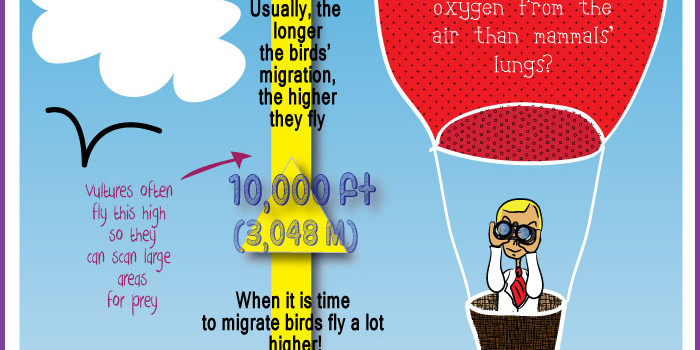
This question comes in from twins Sabha and Lile, who can sometimes be found on the lovely Where Wishes Come From blog. They are two wonderful girls that are fairly mad into science, and their mum tells me that they are always full of questions (we love that around here!). This is the first of two questions they have sent in…
How high do birds fly?
Dr. Simple is, as ever, delighted to answer their question. And this week he has his twin sister with him (which is pretty appropriate don’t you think?). You’ll see below that the regular Dr. Simple post has had a revamp, I love it like this, I hope you do too!
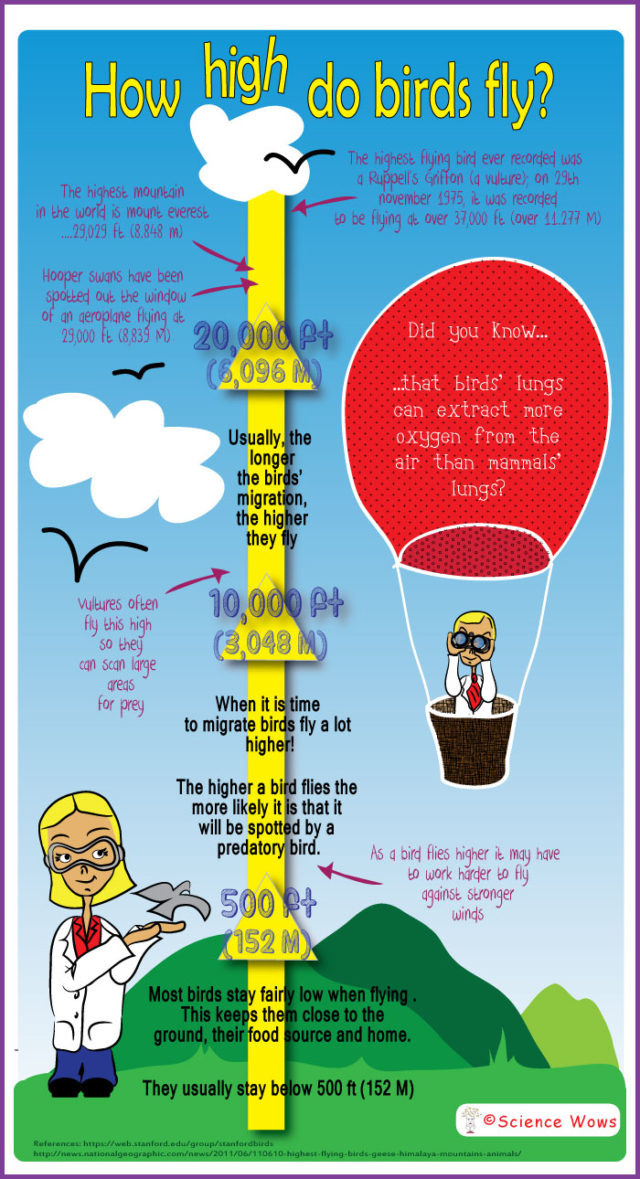
Thanks again to Lile and Sabha for this great question, what super science twins you are!
I hope you like the new layout here, be sure to let me know in the comments below, and remember to send in any questions that you or your family have. We love getting them!
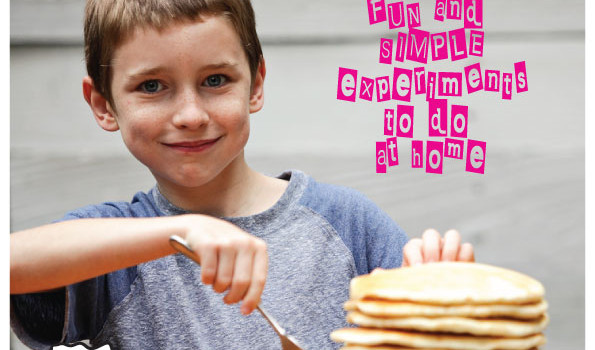
I am very excited to share this latest project with you; this is an idea I have had for a while so I am delighted to have finally finished and published. I really hope you like it and that your junior scientists get plenty of entertainment from this Pancake Science Magazine.
Have a look through and see what you think, there are experiment ideas and a video link to show you how. It is crammed full of interesting facts… from who made the first pancake to the mathematical formula for the perfect pancake flip.
You’ll also find puzzles and quizzes and a free printable download if you prefer to print them off and let the children test their pancake knowledge. There are also some pancake jokes to entertain you all and Dr. Simple can be found throughout the magazine, a familiar face with a few costume changes!
There is a little colour coding for all the subjects covered, from chemistry to astronomy, to maths. So your kids can just dip in and choose their favourites, if they prefer.
I would really love to hear what you think and how your children find this magazine, if you have a minute to give me any feedback I’d be delighted.
I haven’t shown this to my own kids yet, but I think I have this rainy afternoon’s entertainment sorted now.
Hope you Enjoy!
Need a mobile friendly version? just click here! And this is a separate link to the free printable.
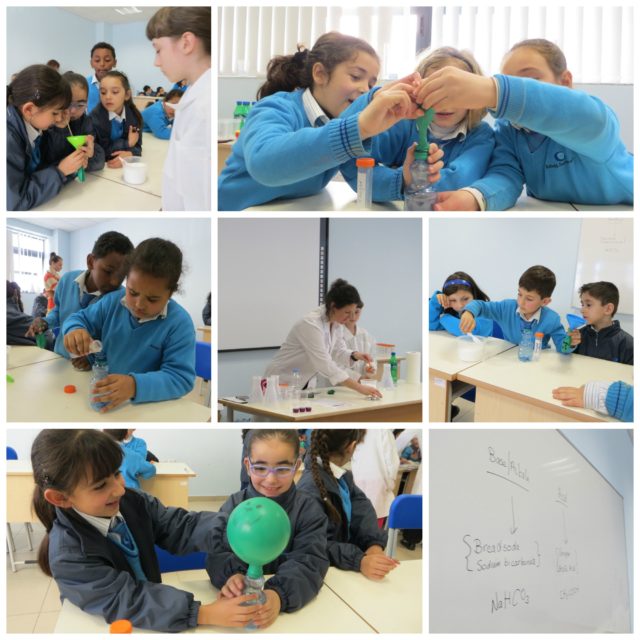
I am just back from a week in Malta. I was attending the annual Science Expo and I was really impressed with how well it was organised and the level of enthusiasm and knowledge among the children. From primary school level, right up to third level, students came up with some great ideas, prepared, tested, recorded and then presented their projects with confidence.
The ideas presented varied widely from what conditions help us on memory tasks to investigating the use of apples to combat dust mite allergies (a subject close to my own heart). The place was abuzz with invention, innovation and imagination.
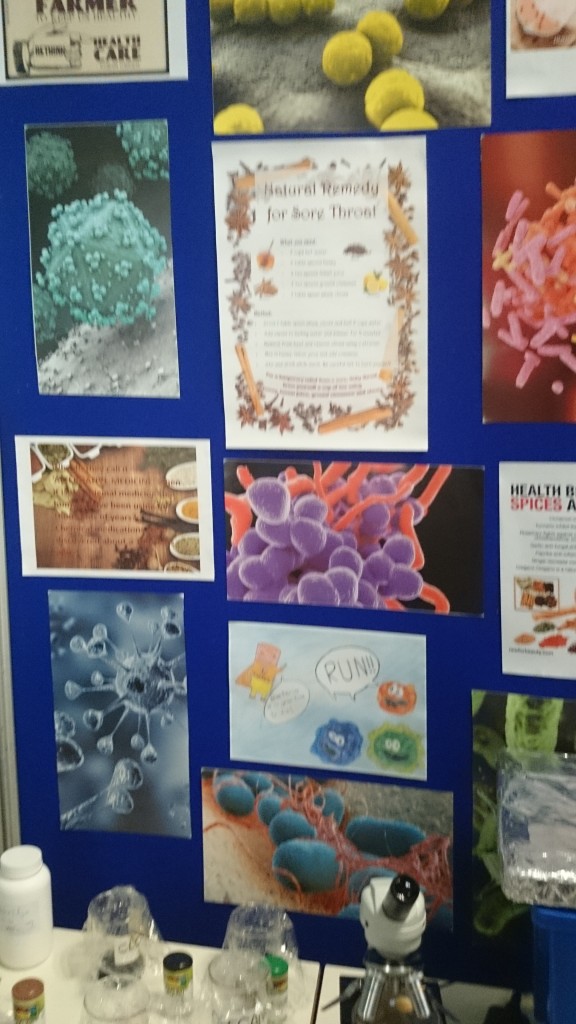
You can check out the winning projects on the NSTF facebook page.
One project looked at the effects of smoking on a number of levels. The team involved went as far as to set up a Facebook page to emphasis their research, a really great idea, you’ll find it here.
WORKSHOPS
There were also a number of workshops running for the week. I ran an interactive one on acids and bases, a workshop created to show children how easy it can be to do science experiments with things you may have in your own kitchen… because science is an anywhere kind of thing.
I was lucky to have my daughter with me for the week, she was a great help and even got to demonstrate the first experiment to the class.
(video credit: Iris Nijman)
This Inflating balloon experiment is a really simple one but I love the squeals of excitement when the balloon starts to grow, even when the children have anticipated what is to come.
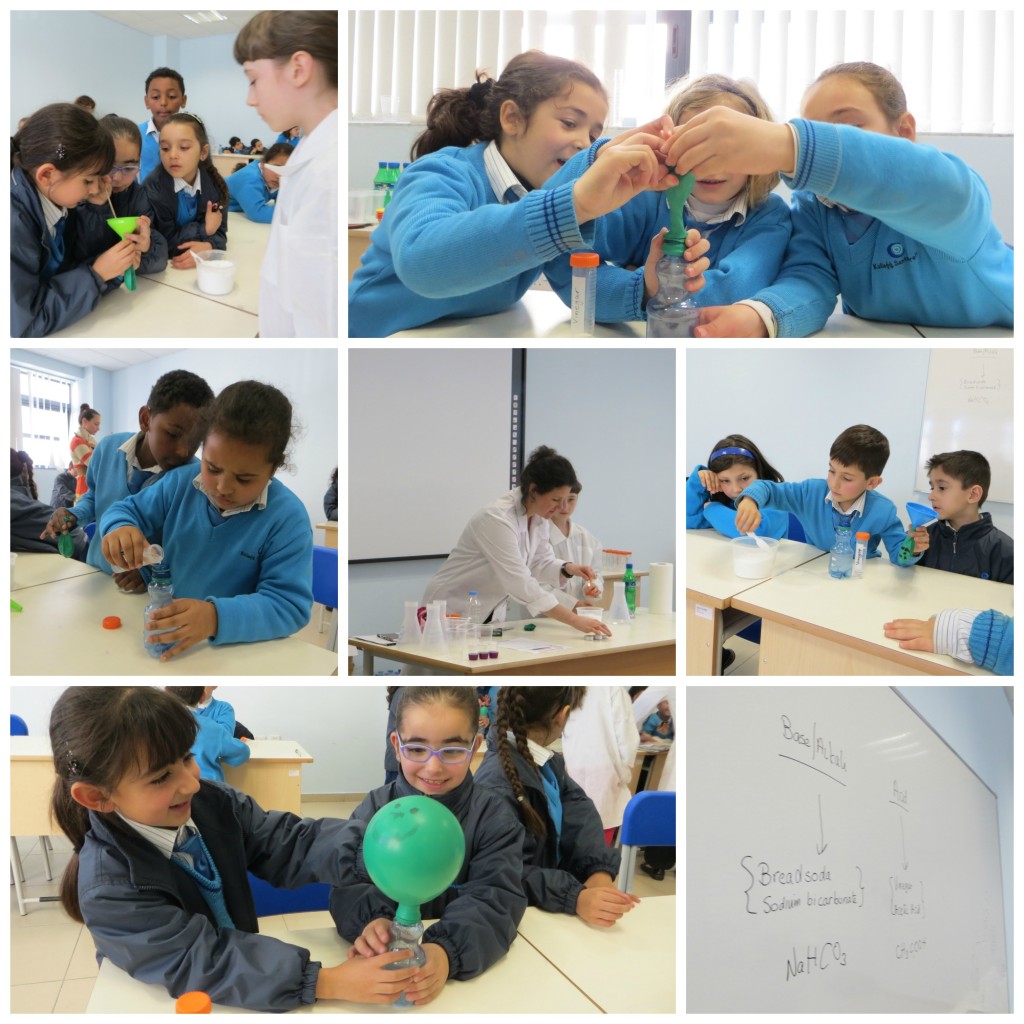
One class to visit my workshop was from the International School in Malta. I was charmed when at the end of the workshop, each child thanked me in their own language. There was 16 kids in total, and I received a thank you in 14 languages!
There were many other great workshops throughout the week, I was just disappointed that I could not sneak in and have a look at them all.
On a national level there was the forensics division of the Maltese police force, explaining to children some of the techniques they use as well as allowing children try some forensic experiments themselves. There was also a very informative shark exhibition run by the shark research centre on the island. My daughter attended their workshop and came back with lots of great facts to share with me.
There was also plenty of international outreach programs represented at the Expo.
Iris Nijman of Universe Aware ran a workshop informing children about the conditions on the planets in our solar system, then the children got to create their own alien that was adapted to life on one of the planets they had learned about. This was a great way to make the workshop interactive for the children and a unique way to make the information much more memorable.
Jeppe Petersen brought an interactive workshop on light to the Expo, funded by the Danish Youth Association of Sciences (UNF) at and the International Movement for Leisure Activities in Science and Technology (MILSET). This workshop was hands on and tailored to each age group and each learning level.
In João Retrê’s workshop children got to make their own planets from the solar system and then place them in their correct location on a scaled model. A great way to get a grasp of the perspective of each planet and its size and distance from its neighbouring planet. This workshop was part of the Portuguese Institute of Astrophysics and Space Sciences outreach program.
Mel Evans, from Cheltenham University, posed some very interesting questions as part of her PhD studies… how accurately is science portrayed in films and what is our interpretation of it? Does the film industry have a moral obligation to depict science with accuracy or is it acceptable to go well beyond the realms of possibility? Do we think that what we see in a film is possible in reality? Mel posed all these questions as she shared and discusses a number of popular film clips and received some very interesting responses from the children and their teachers.
Simon Guilliams from Belgium presented his self-built tri-copter at the Expo. Simon was a winner at the Belgian Science Expo with the tri copter he built in his back yard, starting at the age of 14 and building and improving it over the last four years. His prize was a trip to the Maltese Expo and a chance for him to share his creation.
SOME OF THE SITES OF MALTA
Of course our week in Malta was not all about science, we also got to see some of the island. We were a mere 15 minute bus drive from the beautiful capital, Valetta. We viewed this first by night, on a very informative walking tour of the city (organised by the NSTF). It was lovely to return again and see the same sites by day, soaking up the atmosphere as well as the Sun’s rays. There were many other activities organised for us by the NSTF, including a country walk at the North end of the island and harbour boat trip.
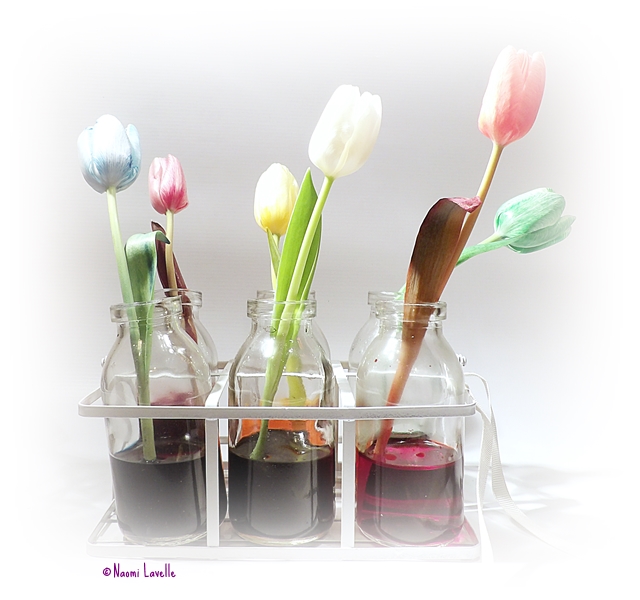
I know I haven’t been blogging much lately, I am trying to work on a little something else that I have wanted to do for a very long time. If I ever get the other project finished I’ll be sharing it right here so watch this space (not literally, it’s taking me a LONG time!).
There is still plenty of science going on in the background though, as is common enough around here. This week we repeated an old favourite, an experiment demonstrating water flow and transpiration in plants… our coloured flower science experiment. I spotted a bunch of pretty white tulips in my local super market and that was all the reason I needed. I had also spotted a set of little bottles while away in Westport last weekend and had to buy them for this experiment, which, I think, elevates my geek status to a whole new level.
I have blogged about this topic before, so if you want more information you can check out this post.
YOU WILL NEED:
*This will work with all (or almost all) white flowers but it works better with some than others. You can of course use other coloured flowers, daffodils are a popular choice. I have achieved good results with roses, carnations, oxeye daisies and some Chrysanthemums. You can choose the flowers based on what you want to achieve but if working with children (particularly young children) or doing this as a classroom project them I would definitely recommend the tulips. The results are rapid so children will be able to see the colour arriving into the flowers within a fairly short time frame.
WHAT TO DO:
Choose how many different colours you want to use. Place one colour into each glass and add water. I usually use at least 10 mls of food colouring to 20 mls of water (if unsure use a 50:50 ration of food colouring to water).
Choose your flowers, one for each glass, and trim them to the desired length. You will get a more rapid result with a shorter stem.
Then simple place a flower in each glass and wait! With these tulips I began to see a result within less than an hour. I set this experiment up overnight and went from this…
… to this…
WHAT IS HAPPENING:
Water is transported up the stem of the flower through little tubes called xylem. The coloured water will travel through the xylem all the way up the stem to various parts of the plant and right up to the flower. The coloured water stains the plant as it moves through it and this is most apparent when the white flowers change colour. The water ultimately evaporates out of the plant through little pores called stromata. This process is called transpiration and is much like perspiration in humans.
OTHER SUGGESTIONS:
If you want to take this one step further you can try to make a multicoloured flower, like I did with this rose last year. Just click on the image to go to the post with full instructions.
If you try this experiment, or a version of it, I would love to hear how it you get on!
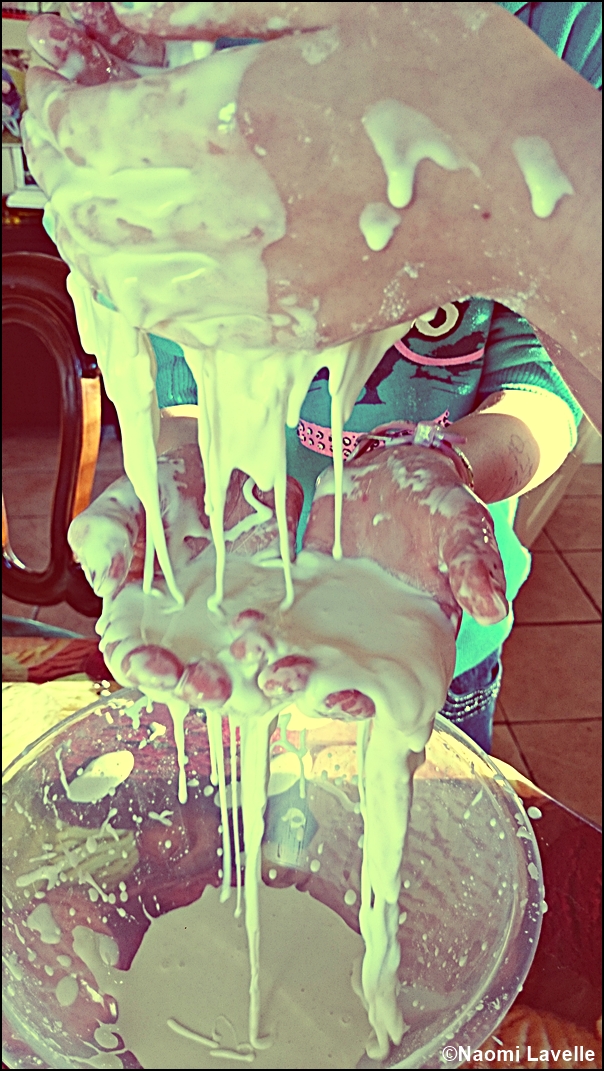
And we’re off! Science week 2014 officially kicks off today. Dr. How’s household has been busy preping for two weeks of school science fun, bringing The Science of Sound into 15 schools. I had a house full of kids today, all happy to help me put the finishing touches to things 😉 The children made a bowl of oobleck and I showed them the effect of sound on this non Newtonian fluid. I love the reaction from children and teachers when we do this experiment in school and I will share it with you later in the week.

The workshops will include buzzing balloons, singing pipes and a whole lot of making noise! If I am not coming to your school you can still catch the workshop at the NUIG Science and Technology Festival Exhibition on Sunday 23rd November.
If you want to find out what is on in your area check out the Science Week Ireland website, or for details on the Galway Science and Technology Festival line up, just click here. You can keep up with it all by following the hastag #Sciweek2014.
Where ever you are and whatever you are doing I hope you get to join in and get hands on with some science.
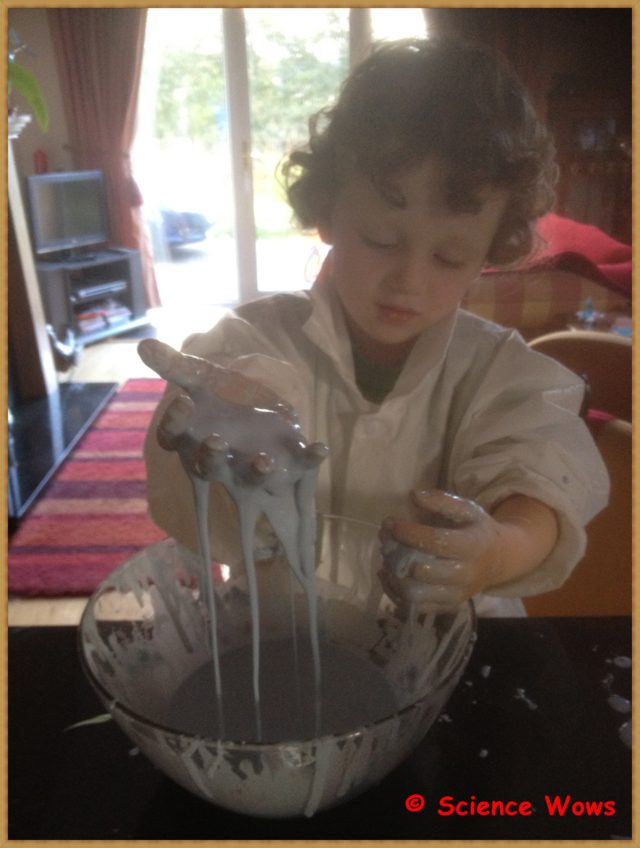
There is a lovely linky running over on the Mama Courage blog. It invites bloggers to get over any hang ups they may have and let the kids get… well messy. Messy play is great for children as a fun, tactile, interactive activity. We are all for it in this house. I thought the linky would be a great wayto share some of our favourite messy experiments with you all.
I hope that these entice you to roll up your sleeves and get stuck in to some messy play science, just don’t look at me when it comes time to clean up!
Here are three of our favourite “messy” science experiments…
Of course this is top of the list… messy and slime are interchangeable really, aren’t they?
This is one of our popular slime recipes…
You will need… two bowls (or cups), borax powder (you can buy this in pharmacists throughout Ireland), water, PVA glue, some stirrers and food colouring of your choice (optional)
What to do…
Add one cup of water to the first bowl and mix in a teaspoon of borax powder until it is all dissolved.
Add a cup of PVA clue to the second bowl; add a cup of water and mix well.
If you would like to colour the slime add a few drops of your chosen food colouring to the glue mixture and mix thoroughly.
Add the borax solution to the glue mixture and start to stir immediately… you will notice that the glue turned to slime almost straight away.
The slime can be stored in an airtight container and will last for years once it is not allowed to dry out.
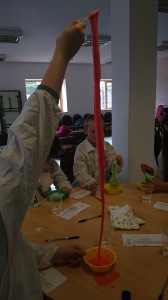
What is happening?…
Congratulation… you have just made a polymer!! In simple terms a polymer is a substance made up of lots of molecules arranged in long chains. If you imagine that the glue is like cooked spaghetti, it slides and slips around the place quite easily. When we add the borax to the glue it causes some of the molecules in the glue to stick together making the glue more rubbery and less liquid! Imagine if you took those strands of spaghetti and tied them together in places, the strands would not be able to slip and slide around nearly as much! The borax and glue mixture is just like your knotted spaghetti!
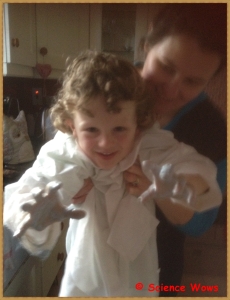
This stuff is very messy but oh so much fun. Not just for the kids either, once adults get their hands on this goo their is no stopping them. It makes a great stress reliever… honestly, have a go!
You will need… A large bowl, cornflour, water, a large spoon to mix and food colouring (optional)
What to do…
Mix the cornflour and water together in the bowl (approximately one cup of cornflour to two cups of water). Add a few drops of food colouring if you wish. Once it is well mixed it’s time to get stuck in. First place your hands into the goo and slowly lift them, watching how it runs through your fingers. Now try punching the surface of the ooblecks with your fist, you may be surprised with the result.
Here is an demo from an enthusiastic member of the Science Wows team:
I left him play while I was making dinner but had to take one more video to show how much fun he was having (you’ve got to watch this one)…
What is happening?…
You have probably all seen the coke and mentos experiment, maybe you have even tried it yourself. The basic idea is that you want to get as many mentos as possible into a bottle of coke as quickly as you can.
Last year I found myself minding two boys who were off “sick” from school. As the day went on it was obvious that they were getting a little less sick and a little more bored. So I decided to give them a challenge (you can read the original post here);
I gave them these …
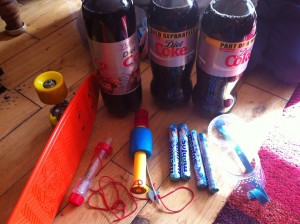
… and told them to devise their own version of the coke and mentos experiment.
This is what they came up with…. (notice the poor teddies that were strapped onto the front of the skateboard!)
So what is happening?...
Firstly, this is not thought to be a chemical reaction between the coke and the mentos. It is most likely a physical reaction known as nucleation; The coke is full of carbon dioxide gas, to give it its fizz; the mentos are full of tiny little craters on the surface of the sweet, the carbon dioxide gas is able to form bubbles in these “craters” producings thousands of tiny bubbles all at once; these bubbles of gas are under a lot of pressure within the bottle of coke and so come shooting out the mouth of the bottle. If anyone knows anything about Newton and his laws they will know that every reaction has an equal and opposite reaction (Newton’s third law of motion)… so the coke comes shooting out of the bottle in one direction and the force of this propels the skate board forward in the opposite direction. PRETTY COOL!